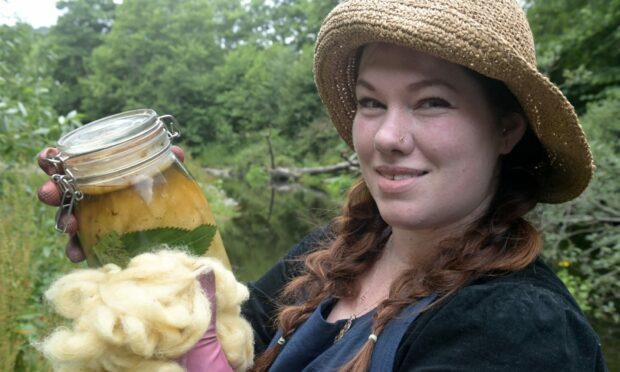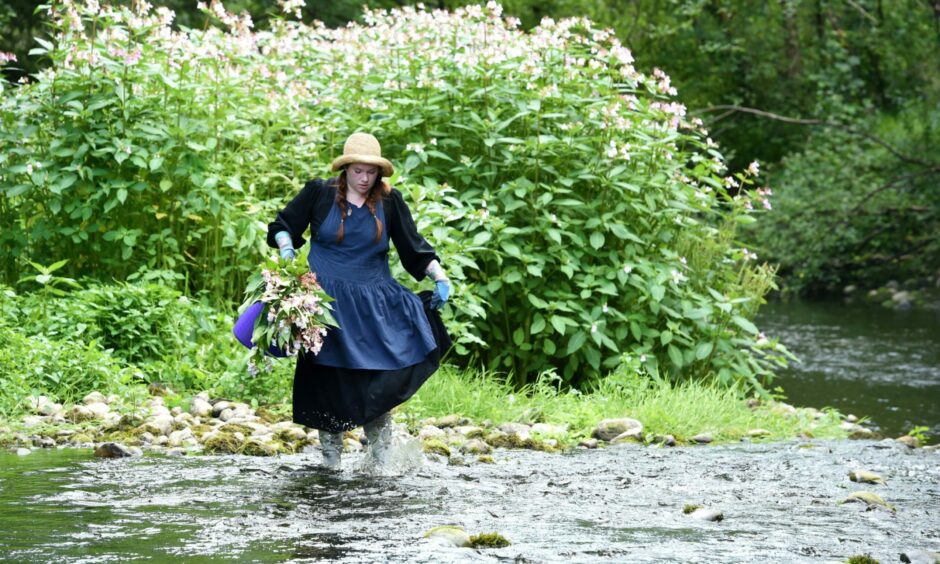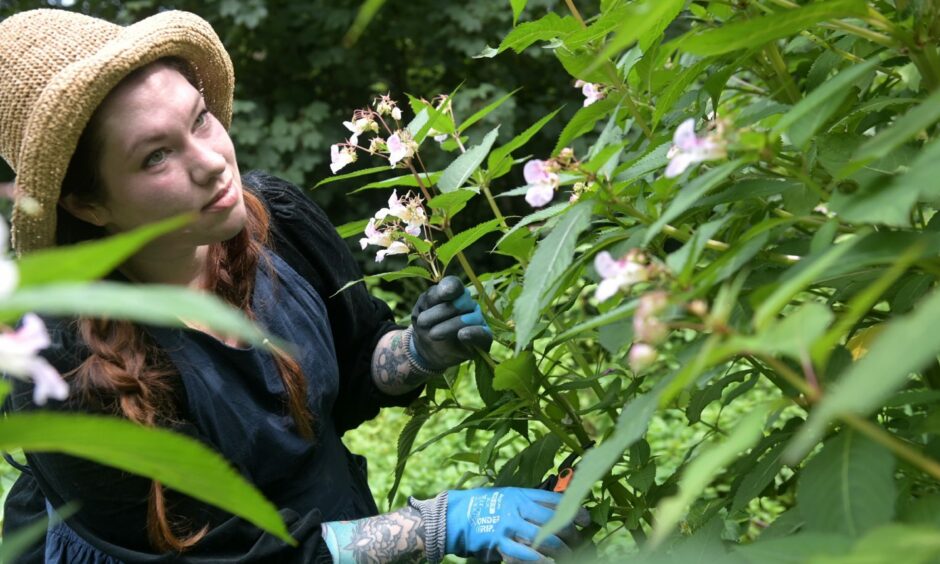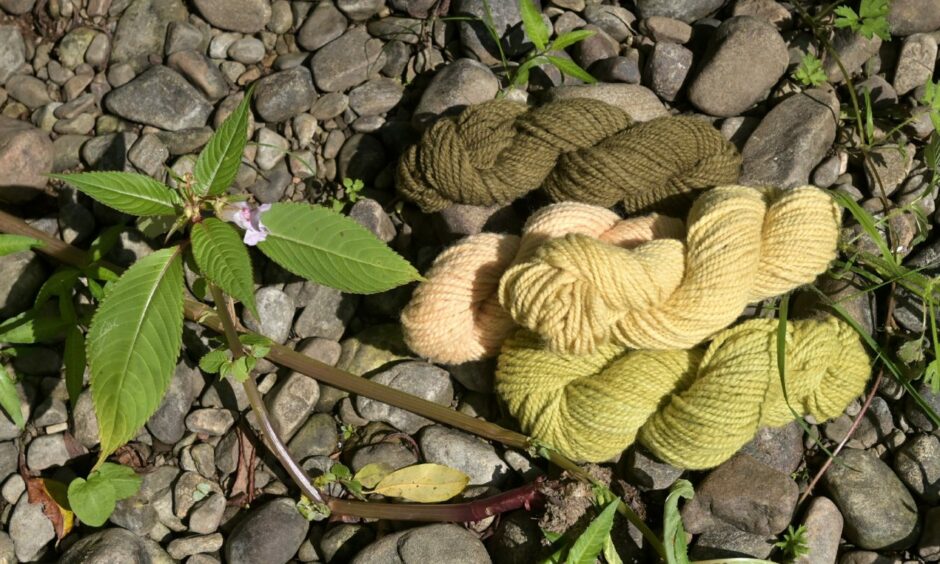To some, Himalayan balsam is just an attractive looking plant; to others it’s an invasive pest that dominates native species.
But to Samantha Farmer, it’s a resource that helps add colour to her products while delivering an environmental message.
Himalayan balsam is beautiful but a problem. Its trumpet-shaped pink and white flowers can grow up to two metres tall and can scatter seeds up to seven metres.
It is one of 36 species of invasive non-native plants that are listed as species of special concern.
A new use for invasive species
Invasive non-native species are harmful to nature and cost Scotland at least £300 million a year.
Himalayan balsam literally puts many native species in the shade, crowding them out and drawing away pollinating insects.
It can also cause bank erosion and contribute to flooding.
At Urquhart Bay on Loch Ness, ‘balsam bashing’ volunteer groups pull up the plants before they go to seed and spread any further.
But Samantha is experimenting with putting them to a new use.
She owns Drumnadrochit-based Highland Magic Fibre Arts, which creates hand-spun yarns.
She is also part owner of Loch Ness Knitting, which uses books and classes to teach about local wool, natural dyeing and knitwear patterns.
The flowering tops of the plant are boiled to make dye for the local sheep’s wool used in her products.
The skeins of yarn will carry an information card spreading awareness about invasive plants and what can be done with them.
Helping native plants
Samantha said: “I’m interested in native plants and traditional dye processes, as well as helping native plants succeed and thrive.
“When I learned about how destructive and invasive it is, I started research into using it as a dye plant.
“I had an idea to try to make use of some of the plant safely and to ensure its destruction in the process.
“As the plant has started to flower but before it goes to seed, the plan is to pull up the plants as usual.
“But, instead of chucking the whole plant aside, I plan to cut off the flowering tops and bag them up.
“The roots and the rest of the plant stay on site, unable to further spread.”
The boiled plant matter is then bagged up and disposed of in household waste.
“This way, we both remove the plants in question and make use of some of the plant in a way that spreads awareness of the issue of garden escapees and their effect on the environment.
“My plan is to offer a special batch of hand-spun local yarn that uses the balsam dye. This will come with a special info card that discusses the issue.
“Many traditionally-used dye plants in the Highlands create shades of yellow. Having an alternative plant to use for yellow was an attractive idea.”
Can Himalayan balsam be used to make gin?
She said customers are interested in the concept of using plants to make colour.
“Many of these people are also ecologically-minded and I anticipate a good response to the project.”
Another potential use for the flowers is to infuse into a floral gin.
“From my research, it’s not only delicious but has a really interesting colour-changing effect when tonic is added to the infused spirit”, says Samantha.
“Of course, this is getting way more enthusiastic interest than the wool.”
Woodland Trust Scotland has consent from NatureScot to remove Himalayan balsam to protect the Urquhart Bay Special Area of Conservation (SAC).
This can be done by contractors, volunteers and others who are confident they know they are removing the correct plant.
To help local people identify and remove Himalayan balsam, the trust is holding a work party day next month.
Ross Watson, site manager North Scotland for Woodland Trust Scotland, plans to visit Cambodia, Slovenia, Croatia and Serbia to examine how these countries tackle invasive species.
He says of Samantha’s project: “To hear of new ideas and innovations to use invasive plants in useful or creative ways is extremely heartening as the more people who are removing these, the quicker the habitats will be allowed to recover.
“To use Himalayan balsam to make gin… I hope it tastes as good as it sounds.”
Handling invasive species must be done in the right way
NatureScot says more than £100,000 has been spent on controlling invasive plants to protect Urquhart Bay Woods, one of the best examples of floodplain woodland in Scotland.
Its experts have contacted Samantha to offer advice on handling Himalayan balsam to avoid transporting seeds or other parts of the plants that might re-grow in another location.
A spokeswoman said: “Himalayan balsam spreads rapidly, outcompetes native vegetation and quickly becomes dominant and can destabilise riverbanks.
“Because there are strict laws governing the handling of invasive plants, it’s vital that it is done in the correct way.”
She said anyone interested in helping tackle invasive species to volunteer for an organised group, such as the Scottish Invasive Species Initiative.
Are you interested in all the latest news and updates from Inverness? If so, why not join our new Facebook group.



